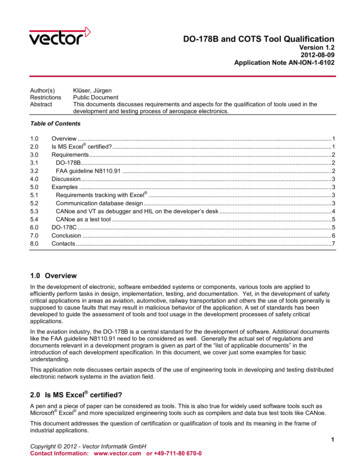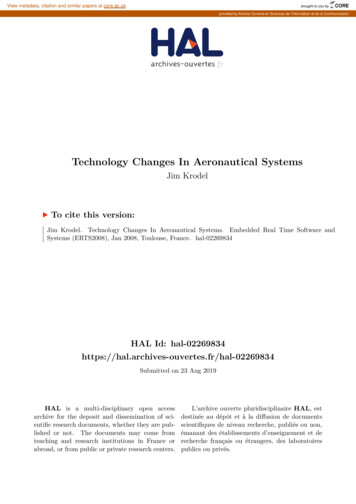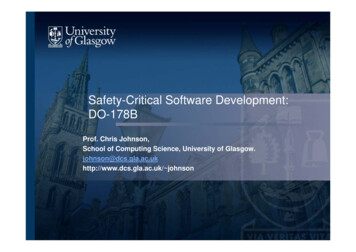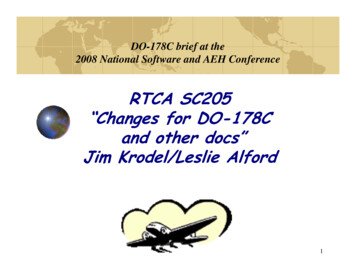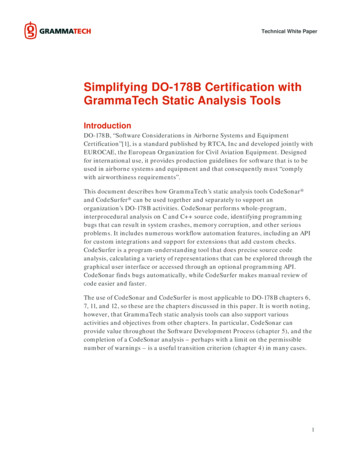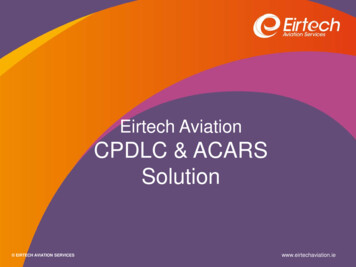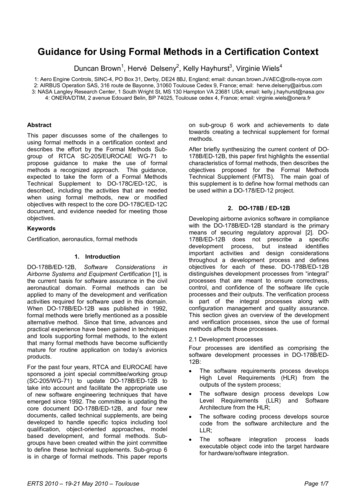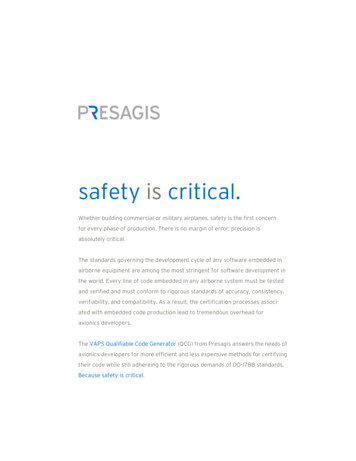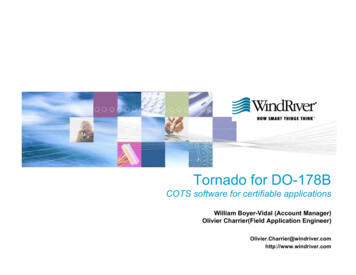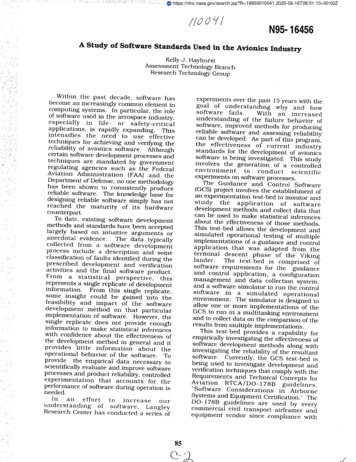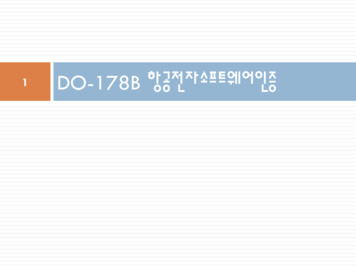
Transcription
1DO-178B 항공전자소프트웨어인증
목차2 DO-178BDO-178B Standard SECTION 1 INTRODUCTIONSECTION 2 SYSTEM ASPECTS RELATING TO SOFTWARE DEVELOPMENTSECTION 3 SOFTWARE LIFE CYCLESECTION 4 SOFTWARE PLANNING PROCESSSECTION 5 SOFTWARE DEVELOPMENT PROCESSESSECTION 6 SOFTWARE VERIFICATION PROCESSSECTION 7 SOFTWARE CONFIGURATION MANAGEMENT PROCESSSECTION 8 SOFTWARE QUALITY ASSURANCE PROCESSSECTION 9 CERTIFICATION LIAISON PROCESSSECTION 10 OVERVIEW OF AIRCRAFT AND ENGINE CERTIFICATIONSECTION 11 SOFTWARE LIFE CYCLE DATASECTION 12 ADDITIONAL CONSIDERATIONSOther
DO-178B3 DO-178B는 항공기 소프트웨어 오작동으로 인한 항공기 사고 위험을 최소화하기 위해 항공기 소프트웨어 안정성에 대한 국제적인 인증 표준이다.항공무선기술협회(RTCA)와 유럽민간항공장비협회(EUROCAE)에서 공동제정하였고, 미국연방항공국(FAA)에서 항공용 제품에 대한 승인 시 SW부분에 적용하고 있다.
DO-178B 제정 과정4
DO-178B5 DO-178B는 항공기 관련 부품 및 탑재시스템의 소프트웨어 생산 가이드라인으로서 감항 (Airworthiness) 요구사항을 충족하기 위한 기준들을 제시하고있다.가이드라인의 대상이 되는 소프트웨어는 그 목표 기능을 정상적으로 수행함과 동시에 안전에 대한 신뢰성을 보장해야 한다.
감항인증6 감항인증항공기의 비행성능의 관점에서 요구사항이 충족되었는가 얼마나 안전한 비행이 이루어지는가 비행범위안정성 제한된 운용범위 내에서 안전을 유지함과 동시에 비행성능이 요구한 대로 발휘되는지를 확인하는 일
DO-178B7 DO-178B의 주요 내용은 다음의 세 영역으로 구분된다.소프트웨어 수명주기 프로세스의 목적 목표 달성을 위한 설계 고려사항 및 활동 내용 기술 목표 충족 여부를 결정할 수 있는 증빙 기준의 기술
DO-178B8
DO-178B9
SECTION 210 SYSTEM ASPECTS RELATING TO SOFTWARE DEVELOPMENT Exchange of data between the system and software life cycle processes(subsection 2.1).Categorization of failure conditions, definition of software levels, andsoftware level determination (subsection 2.2).System architectural considerations (subsection 2.3).System considerations for user-modifiable software, option-selectablesoftware, and commercial off-the-shelf software (subsection 2.4).System design considerations for field-loadable software (subsection2.5).System requirements considerations for software verification (subsection2.6).Software considerations in system verification (subsection 2.7).
SECTION 211 2.1 INFORMATION FLOW BETWEEN SYSTEM ANDSOFTWARE LIFE CYCLE PROCESSES Figure 2-1 is an overview of the safety aspects of theinformation flow between system life cycle processes andthe software life cycle processes. Due to interdependence ofthe system safety assessment process and the system designprocess, the flow of information described in these sections isiterative.
SECTION 212 SYSTEM SAFETY-RELATED INFORMATION FLOWBETWEEN SYSTEM AND SOFTWARE LIFE CYCLEPROCESSES
SECTION 213 2.2 FAILURE CONDITION AND SOFTWARE LEVEL Guidance follows concerning system failure conditioncategories, the definition of software levels, the relationshipbetween software levels and failure condition categories,and how software level is determined. The failure conditioncategory of a system is established by determining theseverity of failure conditions on the aircraft and itsoccupants. An error in software may cause a fault thatcontributes to a failure condition. Thus, the level of softwareintegrity necessary for safe operation is related to thesystem failure conditions.
SECTION 214 2.2.1 Failure Condition Categorization a. Catastrophic: Failure conditions which would prevent continued safe flight and landing.b. Hazardous/Severe-Major: Failure conditions which would reduce the capability of theaircraft or the ability of the crew to cope with adverse operating conditions to the extent thatthere would be: (1) a large reduction in safety margins or functional capabilities,(2) physical distress or higher workload such that the flight crew could not be relied on to perform theirtasks accurately or completely, or(3) adverse effects on occupants including serious or potentially fatal injuries to a small number of thoseoccupants.c. Major: Failure conditions which would reduce the capability of the aircraft or the ability of thecrew to cope with adverse operating conditions to the extent that there would be, for example,a significant reduction in safety margins or functional capabilities, a significant increase in crewworkload or in conditions impairing crew efficiency, or discomfort to occupants, possibly includinginjuries.d. Minor: Failure conditions which would not significantly reduce aircraft safety, and which wouldinvolve crew actions that are well within their capabilities. Minor failure conditions may include,for example, a slight reduction in safety margins or functional capabilities, a slight increase increw workload, such as, routine flight plan changes, or some inconvenience to occupants.e. No Effect: Failure conditions which do not affect the operational capability of the aircraft orincrease crew workload.
SECTION 215
SECTION 216
SECTION 217
SECTION 218
SECTION 219
SECTION 220 2.2.3 Software Level Determination 2.3 SYSTEM ARCHITECTURAL CONSIDERATIONS 2.3.1 Partitioning Partitioning is a technique for providing isolation between functionallyindependent software components to contain and/or isolate faults andpotentially reduce the effort of the software verification process. Ifprotection by partitioning is provided, the software level for eachpartitioned component may be determined using the most severe failurecondition category associated with that component.2.3.2 Multiple-Version Dissimilar Software 2.3.3 Safety Monitoring
SECTION 221 2.4 SYSTEM CONSIDERATIONS FOR USERMODIFIABLE SOFTWARE, OPTIONSELECTABLESOFTWARE AND COMMERCIAL OFF-THE-SHELFSOFTWARE
SECTION 222 2.5 SYSTEM DESIGN CONSIDERATIONS FOR FIELDLOADABLE SOFTWAREDetection of corrupted or partially loaded software. Determination of the effects of loading the inappropriatesoftware. Hardware/software compatibility. Software/software compatibility. Aircraft/software compatibility. Inadvertent enabling of the field loading function. Loss or corruption of the software configurationidentification display.
SECTION 223 2.6 SYSTEM REQUIREMENTS CONSIDERATIONS FORSOFTWARE VERIFICATION The system requirements are developed from the systemoperational requirements and the safety-related requirementsthat result from the system safety assessment process. a. The system requirements for airborne software establish twocharacteristics of the software: (1) The software performs specified functions as defined by the systemrequirements.(2) The software does not exhibit specific anomalous behavior(s) asdetermined by the system safety assessment process. Additional systemrequirements are generated to eliminate the anomalous behavior.b. These system requirements should then be developed into softwarehigh-level requirements that are verified by the software verificationprocess activities.
SECTION 224 2.7 SOFTWARE CONSIDERATIONS IN SYSTEMVERIFICATION
SECTION 325
SECTION 326 This section discusses the software life cycle processes,software life cycle definition, and transition criteriabetween software life cycle processes. The guidelinesof this document do not prescribe a preferredsoftware life cycle, but describe the separateprocesses that comprise most life cycles and theinteractions between them. The separation of theprocesses is not intended to imply a structure for theorganization(s) that perform them. For each softwareproduct, the software life cycle(s) is constructed thatincludes these processes.
SECTION 327 3.1 SOFTWARE LIFE CYCLE PROCESSES3.2 SOFTWARE LIFE CYCLE DEFINITION3.3 TRANSITION CRITERIA BETWEEN PROCESSES
SECTION 328
SECTION 429
SECTION 430 This section discusses the objectives and activities ofthe software planning process. This process producesthe software plans and standards that direct thesoftware development processes and the integralprocesses.
SECTION 431 4.1 SOFTWARE PLANNING PROCESS OBJECTIVES a. The activities of the software development processes and integral processes of thesoftware life cycle that will address the system requirements and software level(s)are defined (subsection 4.2).b. The software life cycle(s), including the inter-relationships between the processes,their sequencing, feedback mechanisms, and transition criteria are determined(section 3).c. The software life cycle environment, including the methods and tools to be used forthe activities of each software life cycle process have been selected (subsection 4.4).d. Additional considerations, such as those discussed in section 12, have beenaddressed, if necessary.e. Software development standards consistent with the system safety objectives forthe software to be produced are defined (subsection 4.5).f. Software plans that comply with subsection 4.3 and section 11 have beenproduced.g. Development and revision of the software plans are coordinated (subsection 4.3).
SECTION 432 4.3 SOFTWARE PLANS The Plan for Software Aspects of Certification (subsection 11.1) servesas the primary means for communicating the proposed developmentmethods to the certification authority for agreement, and defines themeans of compliance with this document.The Software Development Plan (subsection 11.2) defines the softwarelife cycle(s) and software development environment.The Software Verification Plan (subsection 11.3) defines the means bywhich the software verification process objectives will be satisfied.The Software Configuration Management Plan (subsection 11.4) definesthe means by which the software configuration management processobjectives will be satisfied.The Software Quality Assurance Plan (subsection 11.5) defines themeans by which the software quality assurance process objectives will besatisfied.
SECTION 433 a. The software plans should comply with this document.b. The software plans should define the criteria for transitionbetween software life cycle processes by specifying: (1) The inputs to the process, including feedback from other processes.(2) Any integral process activities that may be required to act on theseinputs.(3) Availability of tools, methods, plans and procedures.c. The software plans should state the procedures to be used toimplement software changes prior to use on a certified aircraftor engine. Such changes may be as a result of feedback fromother processes and may cause a change to the software plans.
SECTION 434 4.4 SOFTWARE LIFE CYCLE ENVIRONMENTPLANNING4.4.1 Software Development Environment 4.4.2 Language and Compiler Considerations 4.4.3 Software Test Environment 4.5 SOFTWARE DEVELOPMENT STANDARDS4.6 REVIEW AND ASSURANCE OF THE SOFTWAREPLANNING PROCESS
SECTION 535
SECTION 536 SOFTWARE DEVELOPMENT PROCESSES This section discusses the objectives and activities of the softwaredevelopment processes. The software development processes areapplied as defined by the software planning process (section 4)and the Software Development Plan (subsection 11.2). Table A-2of Annex A is a summary of the objectives and outputs of thesoftware development processes by software level. The softwaredevelopment processes are: Software requirements process.Software design process.Software coding process.Integration process.
SECTION 537 5.1 SOFTWARE REQUIREMENTS PROCESS The software requirements process uses the outputs of thesystem life cycle process to develop the software high-levelrequirements. These high-level requirements includefunctional, performance, interface and safety-relatedrequirements.5.1.1 Software Requirements Process Objectives 5.1.2 Software Requirements Process Activities
SECTION 538 5.1.2 Software Requirements Process Activities a. The system functional and interface requirements that are allocated to software should be analyzed forambiguities, inconsistencies and undefined conditions.b. Inputs to the software requirements process detected as inadequate or incorrect should be reported asfeedback to the input source processes for clarification or correction.c. Each system requirement that is allocated to software should be specified in the high-level requirements.d. High-level requirements that address system requirements allocated to software to preclude system hazardsshould be defined.e. The high-level requirements should conform to the Software Requirements Standards, and be verifiable andconsistent.f. The high-level requirements should be stated in quantitative terms with tolerances where applicable.g. The high-level requirements should not describe design or verification detail except for specified andjustified design constraints.h. Each system requirement allocated to software should be traceable to one or more software high-levelrequirements.i. Each high-level requirement should be traceable to one or more system requirements, except for derivedrequirements.j. Derived high-level requirements should be provided to the system safety assessment process.
SECTION 539 5.2 SOFTWARE DESIGN PROCESS The software high-level requirements are refined throughone or more iterations in the software design process todevelop the software architecture and the low-levelrequirements that can be used to implement Source Code.5.2.1 Software Design Process Objectives 5.2.2 Software Design Process Activities 5.2.3 Designing for User-Modifiable Software
SECTION 540 5.2.2 Software Design Process Activities a. Low-level requirements and software architecture developed during the software designprocess should conform to the Software Design Standards and be traceable, verifiable andconsistent.b. Derived requirements should be defined and analyzed to ensure that the higher levelrequirements are not compromised.c. Software design process activities could introduce possible modes of failure into the softwareor, conversely, preclude others. The use of partitioning or other architectural means in thesoftware design may alter the software level assignment for some components of the software. Insuch cases, additional data should be defined as derived requirements and provided to thesystem safety assessment process.d. Control flow and data flow should be monitored when safety-related requirements dictate,for example, watchdog timers, reasonableness-checks and cross-channel comparisons.e. Responses to failure conditions should be consistent with the safety-related requirements.f. Inadequate or incorrect inputs detected during the software design process should beprovided to either the system life cycle process, the software requirements process, or thesoftware planning process as feedback for clarification or correction.
SECTION 541 5.2.3 Designing for User-Modifiable Software Guidance follows concerning the development of software that isdesigned to be modifiable by its users. A modifiable component is thatpart of the software that is intended to be changed by the user and anon-modifiable component is that which is not intended to be changedby the user. User-modifiable software may vary in complexity. Examplesinclude a single memory bit used to select one of two equipment options,a table of messages, or a memory area that can be programmed,compiled, and linked for aircraft maintenance functions. Software of anylevel can include a modifiable component. a. The non-modifiable component should be protected from the modifiablecomponent to prevent interference in the safe operation of the non-modifiablecomponent. This protection can be enforced by hardware, by software, by thetools used to make the change, or by a combination of the three.b. The applicant-provided means should be shown to be the only means by whichthe modifiable component can be changed.
SECTION 542 5.3 SOFTWARE CODING PROCESS In the software coding process, the Source Code isimplemented from the software architecture and the lowlevel requirements. 5.3.1 Software Coding Process Objectives
SECTION 543 5.3.2 Software Coding Process Activitiesa. The Source Code should implement the low-levelrequirements and conform to the software architecture. b. The Source Code should conform to the Software CodeStandards. c. The Source Code should be traceable to the DesignDescription. d. Inadequate or incorrect inputs detected during thesoftware coding process should be provided to the softwarerequirements process, software design process or softwareplanning process as feedback for clarification or correction.
SECTION 544 5.4 INTEGRATION PROCESS The target computer, and the Source Code and object codefrom the software coding process are used with the linkingand loading data (subsection 11.16) in the integrationprocess to develop the integrated airborne system orequipment.5.4.1 Integration Process Objectives 5.4.2 Integration Process Activities 5.4.3 Integration Considerations
SECTION 545 5.4.2 Integration Process Activities The integration process consists of software integration andhardware/software integration.The integration process may be entered or re-entered when theplanned transition criteria have been satisfied. The integrationprocess inputs are the software architecture from the softwaredesign process, and the Source Code and object code from thesoftware coding process.The outputs of the integration process are the Executable ObjectCode, as defined in subsection 11.12, and the linking andloading data. The integration process is complete when itsobjectives and the objectives of the integral processes associatedwith it are satisfied. Guidance for this process includes:
SECTION 546 5.4.3 Integration Considerations The following are considerations for deactivated code andsoftware patches. An airborne system or equipment may bedesigned to include several configurations, not all of whichare intended to be used in every application. This can leadto deactivated code that cannot be executed or data that isnot used. This differs from dead code which is defined in theglossary and discussed in subparagraph 6.4.4.3. Guidancefor deactivated code and patches includes:
SECTION 547 a. Evidence should be available that the deactivated code is disabled for theenvironments where its use is not intended. Unintended activation of deactivatedcode due to abnormal system conditions is the same as unintended activation ofactivated code.b. The methods for handling deactivated code should comply with the softwareplans.c. Patches should not be used in software submitted for use in a certified aircraft orengine to implement changes in requirements or architecture, or changes foundnecessary as a result of software verification process activities. Patches may beused on a limited, case-by-case basis, for example, to resolve known deficiencies inthe software development environment, such as a known compiler problem.d. When a patch is used, these should be available: (1) Confirmation that the software configuration management process can effectively track thepatch.(2) Regression analysis to provide evidence that the patch satisfies all objectives of the softwaredeveloped by normal methods.(3) Justification in the Software Accomplishment Summary for the use of a patch.
SECTION 548 5.5 TRACEABILITY a. Traceability between system requirements and softwarerequirements should be provided to enable verification of thecomplete implementation of the system requirements and givevisibility to the derived requirements.b. Traceability between the low-level requirements and high-levelrequirements should be provided to give visibility to the derivedrequirements and the architectural design decisions made duringthe software design process, and allow verification of thecomplete implementation of the high-level requirements.c. Traceability between source code and low-level requirementsshould be provided to enable verification of the absence ofundocumented source code and verification of the completeimplementation of the low-level requirements.
SECTION 649
SECTION 650 This section discusses the objectives and activities ofthe software verification process. Verification is atechnical assessment of the results of both thesoftware development processes and the softwareverification process. The software verification processis applied as defined by the software planningprocess (section 4) and the Software Verification Plan(subsection 11.3).
SECTION 651 6.1 SOFTWARE VERIFICATION PROCESS OBJECTIVES The purpose of the software verification process is to detect and reporterrors that may have been introduced during the software developmentprocesses. Removal of the errors is an activity of the software developmentprocesses. The general objectives of the software verification process are toverify that: a. The system requirements allocated to software have been developed into softwarehigh-level requirements that satisfy those system requirements.b. The high-level requirements have been developed into software architecture andlow-level requirements that satisfy the high-level requirements. If one or more levels ofsoftware requirements are developed between high-level requirements and low-levelrequirements, the successive levels of requirements are developed such that eachsuccessively lower level satisfies its higher level requirements. If code is generateddirectly from high-level requirements, this objective does not apply.c. The software architecture and low-level requirements have been developed intoSource Code that satisfies the low-level requirements and software architecture.d. The Executable Object Code satisfies the software requirements.e. The means used to satisfy these objectives are technically correct and complete forthe software level.
SECTION 652 6.2 SOFTWARE VERIFICATION PROCESS ACTIVITIES The verification process provides traceability between the implementation of the softwarerequirements and verification of those software requirements: The traceability between the software requirements and the test cases is accomplished by therequirements-based coverage analysis.The traceability between the code structure and the test cases is accomplished by the structural coverageanalysis.a. High-level requirements and traceability to those high-level requirements should be verified.b. The results of the traceability analyses and requirements-based and structural coverageanalyses should show that each software requirement is traceable to the code that implements itand to the review, analysis, or test case that verifies it.c. If the code tested is not identical to the airborne software, those differences should bespecified and justified.d. When it is not possible to verify specific software requirements by exercising the software in arealistic test environment, other means should be provided and their justification for satisfying thesoftware verification process objectives defined in the Software Verification Plan or SoftwareVerification Results.e. Deficiencies and errors discovered during the software verification process should be reportedto the software development processes for clarification and correction.
SECTION 653 6.3 SOFTWARE REVIEWS AND ANALYSES6.3.1 Reviews and Analyses of 6.3.2 Reviews and Analyses of 6.3.3 Reviews and Analyses of 6.3.4 Reviews and Analyses of 6.3.5 Reviews and Analyses ofIntegration Process 6.3.6 Reviews and Analyses ofand Results the High-Level Requirementsthe Low-Level Requirementsthe Software Architecturethe Source Codethe Outputs of thethe Test Cases, Procedures
SECTION 654 6.4 SOFTWARE TESTING
SECTION 655
SECTION 656 6.4.2 Requirements-Based Test Case Selection6.4.2.1 Normal Range Test Cases 6.4.2.2 Robustness Test Cases 6.4.3 Requirements-Based Testing Methodsa. Requirements-Based Hardware/Software IntegrationTesting b. Requirements-Based Software Integration Testing c. Requirements-Based Low-Level Testing
SECTION 657 6.4.4 Test Coverage Analysis6.4.4.1 Requirements-Based Test Coverage Analysis 6.4.4.2 Structural Coverage Analysis 6.4.4.3 Structural Coverage Analysis Resolution
SECTION 758
SECTION 759 This section discusses the objectives and activities ofthe software configuration management (SCM)process. The SCM process is applied as defined bythe software planning process (section 4) and theSoftware Configuration Management Plan (subsection11.4). Outputs of the SCM process are recorded inSoftware Configuration Management Records(subsection 11.18) or in other software life cycle data.
SECTION 760 7.2 SOFTWARE CONFIGURATION MANAGEMENTPROCESS ACTIVITIES 7.2.1 Configuration Identification7.2.2 Baselines and Traceability7.2.3 Problem Reporting, Tracking and Corrective Action7.2.4 Change Control7.2.5 Change Review7.2.6 Configuration Status Accounting7.2.7 Archive, Retrieval and Release7.2.8 Software Load Control7.2.9 Software Life Cycle Environment Control
SECTION 761 7.3 DATA CONTROL CATEGORIES Software life cycle data can be assigned to one of twocategories: Control Category 1 (CC1)Control Category 2 (CC2)These categories are related to the configurationmanagement controls placed on the data. Table 7-1 definesthe set of SCM process objectives associated with eachcontrol category, where ø indicates that the objectives applyfor software life cycle data of that category.
SECTION 762
SECTION 863
SECTION 864 This section discusses the objectives and activities of thesoftware quality assurance (SQA) process. The SQA process isapplied as defined by the software planning process (section 4)and the Software Quality Assurance Plan (subsection 11.5).Outputs of the SQA process activities are recorded inSoftware Quality Assurance Records (subsection 11.19) orother software life cycle data.The SQA process assesses the software life cycle processes andtheir outputs to obtain assurance that the objectives aresatisfied, that deficiencies are detected, evaluated, trackedand resolved, and that the software product and software lifecycle data conform to certification requirements.
SECTION 865 8.1 SOFTWARE QUALITY ASSURANCE PROCESSOBJECTIVES The SQA process objectives provide confidence that thesoftware life cycle processes produce software thatconforms to its requirements by assuring that these processesare performed in compliance with the approved softwareplans and standards. a. Software development processes and integral processes complywith approved software plans and standards.b. The transition criteria for the software life cycle processes aresatisfied.c. A conformity review of the software product is conducted.
SECTION 866 8.2 SOFTWARE QUALITY ASSURANCE PROCESSACTIVITIES8.3 SOFTWARE CONFORMITY REVIEW
SECTION 967
SECTION 968 The objective of the certification liaison process is toestablish communication and understanding betweenthe applicant and the certification authoritythroughout the software life cycle to assist thecertification process.The certification liaison process is applied as definedby the software planning process (section 4) and thePlan for Software Aspects of Certification (subsection11.1).
SECTION 1069
SECTION 1070 This section is an overview of the certification processfor aircraft and engines with respect to softwareaspects of airborne systems and equipment, and isprovided for information purposes only. Thecertification authority considers the software as partof the airborne system or equipment installed on theaircraft or engine; that is, the certification authoritydoes not approve the software as a unique, standalone product.
SECTION 1171
SECTION 1172 Data is produced during the software life cycle toplan, direct, explain, define, record, or provideevidence of activities. This data enables the softwarelife cycle processes, system or equipment certification,and post-certification modification of the softwareproduct. This section discusses the characteristics, form,configuration management controls, and content ofthe software life cycle data.
SECTION 1173 The characteristics of the software life cycle data are: a. Unambiguous: Information is unambiguous if it is written in terms which only allow a singleinterpretation, aided if necessary by a definition.b. Complete: Information is complete when it includes necessary, relevant requirements and/ordescriptive material, responses are defined for the range of valid input data, figures used arelabeled, and terms and units of measure are defined.c. Verifiable: Information is verifiable if it can be checked for correctness by a person or tool.d. Consistent: Information is consistent if there are no conflicts within it.e. Modifiable: Information is modifiable if it is structured and has a style such that changes canbe made completely, consistently, and correctly while retaining the structure.f. Traceable: Information is traceable if the origin of its components can be determined.In addition, this guidance applies:g. Form: The form should provide for the efficient retrieval and review of software life cycledata throughout the service life of the airborne system or equipment. The data and the specificform of the data should be specified in the Plan for Software Aspects of Certification.h. Control: If intended to be used for this purpose, this data should be defined in the softwareplan which defines the process for which the data will be produced. While the nature andcontent of this data may vary, as a minimum, CC2 controls should be applied. Examples includememoranda and meeting minutes.
SECTION 1174 11.1 PLAN FOR SOFTWARE ASPECTS OF CERTIFICATION a. System overview: This section provides an overview of the system, including a description of its functions and their allocation tothe hardware and software, the architecture, processor(s) used, hardware/software interfaces, and safetyb. Software overview: This section briefly describes the software functions with emphasis on the proposed safety and partitioningconcepts, for example, resource sharing, redundancy, multiple-version dissimilar software, fault tolerance, and timing andscheduling strategies.c. Certification considerations: This section provides a summary of the certification basis, including the means of compliance, asrelating to the software aspects of certification. This section also states the proposed software lev
항공무선기술협회(rtca)와 유럽민간항공장비협회(eurocae)에서 공동 제정하였고, 미국연방항공국(faa)에서 항공용 제품에 대한 승인 시 sw부분 에 적용하고 있다. 3 . do-178b 제정 과정 4 . do-178b do-178b는 항공기 관련 부품 및 탑재시스템의 소프트웨어 생산 가이드라 .
